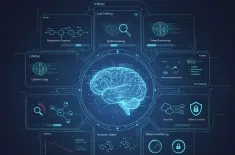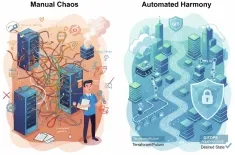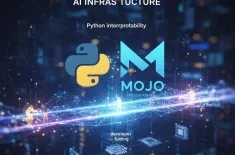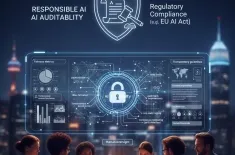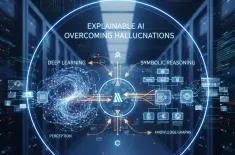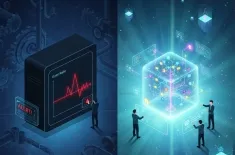Explore how Generative AI tools like Copilot are revolutionizing software development with AI code generation, code completion, automated testing, and powerful debugging AI
The landscape of software development is undergoing a seismic shift, fundamentally driven by the rise of Generative AI. Once a domain exclusive to human ingenuity, the processes of writing, completing, debugging, and testing code are now being augmented—and in some cases, fully automated—by sophisticated AI models. This transition marks the dawn of GenAI for software development, dramatically increasing developer productivity and reshaping the role of the modern engineer.
This article delves into the core functionalities and transformative impact of these tools, examining how they are not just assisting, but actively driving efficiency across the entire Software Development Life Cycle (SDLC).
The Dawn of AI Code Generation and Completion
The most visible and widely adopted application of Generative AI in coding is the ability to generate and complete code in real-time. This functionality moves far beyond the rudimentary auto-suggestions of older IDEs; it is a true AI pair programmer that understands context, style, and intent.
The Rise of Copilot and Code Completion
The flagship of this movement is Copilot, developed by GitHub in collaboration with OpenAI. Copilot operates as an in-line assistant, providing suggestions ranging from a single line to entire functions based on the developer’s current code context, open files, and even natural language comments.
The use of Generative AI tools to write, complete, debug, and translate code, dramatically increasing developer productivity stems from the core mechanism of these Large Language Models (LLMs). Trained on vast datasets of public code, these models learn the patterns, syntax, and conventions of nearly every programming language. When a developer starts typing a function name or a comment describing the desired functionality (e.g., // function to fetch user data from API), the AI can instantly synthesize the required code block.
Key impacts of advanced code completion include:
- Reduction of Boilerplate Code: Repetitive, standard setup code for things like constructors, getters, setters, or database connection functions are instantly generated, freeing developers from tedious, low-value work.
- Accelerated Prototyping: Developers can rapidly test concepts and build initial versions of features simply by describing them in plain English, greatly reducing the time from idea to functional code.
- Educational Tool: For developers learning a new framework or language, the AI acts as a patient tutor, demonstrating best practices and providing correct syntax in real-time.
While AI code generation is powerful, its true value is realized when it is fully context-aware, understanding an entire codebase—a crucial component for large enterprise development. Tools like Amazon Q Developer and Sourcegraph Cody are emerging to specifically address this, leveraging an organization's internal codebases to provide highly relevant, internal-style-compliant suggestions.
Debugging AI and Error Remediation
One of the most time-consuming aspects of software development is not writing the code, but fixing the code that has been written. The average developer spends a significant portion of their time identifying, isolating, and resolving bugs. Generative AI is now fundamentally transforming this process with powerful debugging AI capabilities.
Automated Diagnosis and Fix Suggestions
Traditional debugging relies on stepping through code line-by-line or interpreting cryptic error logs. Modern AI tools, however, can perform semantic analysis of the codebase, which means they understand the intent of the code, not just the syntax.
When an error occurs, the debugging AI can:
- Analyze Stack Traces: It ingests complex error messages and stack traces, translating them into plain language explanations of the root cause, making it instantly understandable even for less experienced developers.
- Suggest Contextual Fixes: Based on the error and the surrounding code, the AI can propose specific, working code snippets to fix the issue, often with a high degree of accuracy.
- Predictive Debugging: By learning from millions of historical bugs and known vulnerability patterns, some advanced tools can flag potential errors before the code is even run—for example, spotting a common security vulnerability like SQL injection during the code completion phase.
This move from reactive bug fixing to proactive, predictive error prevention is one of the most critical transformations offered by GenAI for software development. The time saved in the fix-test-redeploy cycle translates directly into faster delivery times and higher overall product quality.
Automated Testing and Quality Assurance
Testing is the safety net of software development. Comprehensive testing ensures that new code does not break existing features (regressions) and that all functionality meets user requirements. AI is revolutionizing this domain through automated testing at an unprecedented scale, moving testing from a labor-intensive chore to an intelligent, continuous process.
AI-Driven Test Case Generation
The cornerstone of AI in QA is the ability to automatically generate test assets. GenAI models can analyze user stories, functional specifications, and existing code to autonomously create a comprehensive suite of tests.
- Unit and Integration Tests: Tools can generate high-quality unit tests for individual functions and integration tests for how different components interact. For example, a developer can prompt the AI, "Generate unit tests for the 'processOrder' function covering success, invalid input, and out-of-stock scenarios," and the system will write the code for all three tests, including mock data and assertions. This significantly boosts code coverage, a key metric for quality.
- Test Data Generation: Generating realistic, non-sensitive, high-volume test data is often a blocker for large-scale automated testing. GenAI can create synthetic data sets that mimic real-world user behavior and complex edge cases, ensuring more thorough validation.
Self-Healing and Context-Aware Maintenance
A major challenge with traditional automated testing is maintenance. Tests often break when minor changes occur in the User Interface (UI) (e.g., a button's ID changes), leading to "flaky" tests that require constant manual updates. Modern AI testing platforms address this with self-healing features.
- Intelligent Locators: If an element’s locator (like its CSS ID or XPath) changes, the AI can identify the new element by analyzing surrounding attributes, visual cues, and the underlying DOM structure. It then automatically updates the test script, dramatically reducing test maintenance overhead.
- Optimization and Prioritization: The AI can observe the codebase and determine which tests are most critical to run based on the latest code changes. Instead of running the entire suite, it prioritizes relevant tests, saving time and computing resources in the Continuous Integration/Continuous Deployment (CI/CD) pipeline.
Challenges, Limitations, and The Human Element
Despite the clear advantages, the integration of AI code generation and automated testing is not without its challenges. The industry recognizes that these tools are augmentation, not replacement.
Accuracy and Hallucinations
AI models, while highly accurate, can occasionally generate plausible-looking but functionally incorrect code—a phenomenon often referred to as "hallucination." Furthermore, AI-generated code might be inefficient, verbose, or fail to adhere to specific, unique company coding standards.
This is why the human element remains critical:
- Code Review is Essential: Every piece of AI-generated code must be reviewed, tested, and approved by a human developer. The developer's role shifts from a coder to an AI orchestrator or intent engineer who guides the AI and vets its output for correctness and quality.
- Context is King: The effectiveness of tools like Copilot is directly tied to the context they are provided. Developers must master "prompt engineering" to give the AI clear, concise instructions and keep relevant files open to maximize the quality of suggestions.
Security and Intellectual Property
A significant concern is that AI models trained on public code might inadvertently generate code snippets containing security vulnerabilities or proprietary logic. Reputable tools, like Amazon Q Developer, now incorporate debugging AI and security scanners to automatically detect and flag common vulnerabilities in the generated code, mitigating this risk. However, intellectual property and licensing risks related to the training data remain an ongoing legal and technical area of focus for the industry.
The Future: Agentic AI and Full Automation
The current generation of GenAI for software development tools are "Copilots"—assistants that work alongside a human. The next phase involves Agentic AI.
These autonomous agents will be capable of taking a high-level goal, such as "Implement a new feature to allow users to reset their password," and then autonomously:
- Breaking Down the Task: Devising a multi-step plan (API endpoint, database schema update, frontend UI change, logging).
- Generating and Editing Code: Writing the necessary code across multiple files.
- Self-Correction: Running the code, identifying errors using the debugging AI, and automatically fixing the issues.
- Creating Tests: Generating the full suite of automated testing cases to validate the new feature.
- Submitting for Review: Creating a pull request with a detailed description and smart commit messages.
This level of automation will further redefine the developer’s role, shifting focus entirely to high-level system architecture, design decisions, and managing the AI agents' workflows.
Conclusion
The convergence of large language models and software engineering has ushered in a new era of productivity. AI code generation, exemplified by tools like Copilot, has made the task of writing code faster and more accessible. Paired with sophisticated debugging AI and intelligent automated testing systems, GenAI for software development is creating a seamless, accelerated development workflow.
The developer is empowered to move beyond repetitive tasks and concentrate on complex problem-solving and creative design. As these AI systems evolve from intelligent assistants to autonomous agents, the software industry will continue to experience exponential growth in output and quality, permanently cementing AI’s role as an indispensable partner in the creation of technology.

